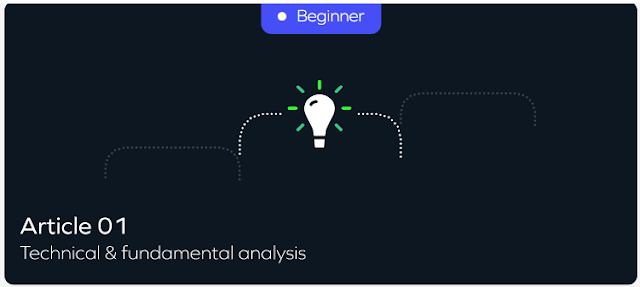The Difference between Technical and Fundamental Analysis
They are the foundations of informed trading. Here’s what you need to know about them.
Technical Analysis and Fundamental Analysis are the main methods to identify trading opportunities in the financial markets. Both have a common goal – to help you predict future price movements of an asset. But the two differ in the tools they employ to draw conclusions and the way they are applied to various financial instruments.
Fundamental Analysis
This aims to measure the intrinsic value of an asset, which is then used to predict future price changes. The intrinsic value is determined by analysing industrial, demographic, economic and company data. In essence, fundamental analysis looks at all factors internal and external to identify whether an asset is overpriced or under-priced. It looks at historical and present data of the markets, economy and the industry for future predictions.
Fundamental analysis works on the assumption that the market corrects itself so that the asset returns to its fair value. This suggests that traders can choose to buy undervalued assets and then wait for the market to correct. This will take the price up, when the trader can sell. The opposite holds true for over-valued assets.
Paying attention to the latest news headlines is vital for a fundamental analysis strategy, as world events such as the US’s NonFarm Payrolls report, Covid-19 and the war in Ukraine can impact the price of an asset. ADSS offers daily market analysis to clients that could help you plan your trading strategy.
Technical Analysis
Technical analysis studies historical data to predict future price trends. This data includes price patterns, trading volumes, market trends, and more. The tools used to extrapolate future price changes from past trends are indicators that analyse the price, time, volume and width of various parametres.
Technical analysis is based on the assumption that markets follow trends. Although this is mostly true, unprecedented events could reverse such trends.
Here’s a look at how the two types of analyses differ.
Time Horizon
Fundamental analysis is a long-term approach. For instance, if you’re trading stocks, you would undertake extensive research about the company, industry, its management and profitability.
Technical analysis, on the other hand, focuses on durations as short as a few minutes to a few days or weeks. Powerful trading platforms, such as the ADSS MT4 platform, offer powerful tools for technical analysis.
Tools of Analysis
Both methodologies have their own sets of indicators to predict prices.
Indicators for Fundamental Analysis
A macro and micro perspective are required to carry out fundamental analysis. This includes a study of:
1. The state of the economy
2. The strength of the specific industry
3. Company performance
Fundamental Analysis for Trading Stocks
The analysis for stocks can be classified into Qualitative and Quantitative factors to help deduce the intrinsic value of an asset.
Qualitative Analysis
This requires the study of the business model and its competitive advantage in the industry. Additionally, the industry to which the stock belongs impacts the asset valuation over the long run. Above all, the management and corporate governance that drives the business is taken into account.
Quantitative Analysis
Financial statements, such as the quarterly earnings reports, provide an insight into the company’s financial health. There are three essential financial statements that traders consider: income statements, balance sheet and cash flow statements. These statements provide information on the debts and liabilities of the company, while also revealing the status of their financials, such as profits, expenses, etc.
Did you know?
Financial ratios are drawn from quantitative parametres that help fundamental analysts draw conclusions.
Fundamental Analysis for Trading Forex
Forex prices are most influenced by economic events and central bank policy decisions.
Central Bank Announcements
The primary activity that adds volatility to the market is a change in interest rates. Additionally, monetary policies, asset purchases, currency revaluations all affect the liquidity in the market.
Economic Data
Data on the nation’s GDP and unemployment rate can impact the value of the domestic currency. Inflation is another key economic indicator, which measures the purchasing power of a currency.
Fundamental Analysis for Trading Cryptocurrency
Cryptocurrency prices are affected by developments associated with the project they are linked to.
Project Metrics
These include the whitepaper, founding team and the roadmap of the project. Analysts deduce the viability and legitimacy of the project by deeply studying these documents.
Financial Metrics
These include the market cap and tokenomics of the asset. Tokenomics involves metrics regarding total circulating supply and distribution philosophy of the crypto.
On-Chain Analysis
These are the metrics derived from the transaction volumes, and direction and health of the blockchain network. Basically, the underlying technology and its behaviour play an important role.
Did you know?
All crucial pointers of technical analysis are dependent only on the price of the asset, studied over a period of time.
Indicators for Technical Analysis
Stocks, futures, commodities, fixed-income securities, currencies and other financial instruments for which you can access historical trading data can be traded using technical analysis. Trading decisions are based on the mathematical patterns that the historical data reflects on the price chart of the asset. These also include understanding the market sentiment and how it can affect asset valuation.
Technical indicators are classified into four major categories. There isn’t any single indicator that works for all assets or market conditions. Traders need to use indicators at their discretion and carefully combine two or more to make trading decisions.
Momentum Indicators
These reflect how quickly or slowly the price of an asset is moving and strength of the price movements. The most commonly used momentum indicators are moving average convergence divergence (MACD), Average Directional Index, Stochastic Oscillator and Relative Strength Index.
Trend Indicators
These indicators help identify an existing trend and whether it is likely to continue. This can help you determine appropriate long and short positions. A few examples of trend indicators are moving averages, Bollinger Bands, Relative Strength Index and parabolic SAR.
Volume Indicators
Volume measures express how many trades are taking place at any point of time. They are leading indicators of whether price trends will continue or reverse. Money Flow Index, Ease of Movement, Accumulation/Distribution and On-Balance Volume are a few of commonly used indicators.
Volatility Indicators
These indicators help gauge whether the market is consolidating or trending. Industry or economic developments can lead to market volatility. This is the most commonly used class of indicators and some of the most popular ones are Bollinger Bands, Kelter Channels and Average True Range.
Experienced traders recommend a combination of fundamental and technical analysis for informed decision making. However, using too many indicators can clutter up the charts and lead to confusion. Familiarise yourself with both types of analysis through a demo account and choose the indicators that work best for you.
Key Takeaways
1. Fundamental and technical analyses are crucial in predicting future price moves.
2. Fundamental analysis studies the intrinsic or fair value of an asset.
3. Technical analysis studies the historical price and volume movements to predict future price direction.
Open a live account with ADSS and access powerful trading tools to trade the global markets.
Disclaimer: This article is an educational guide to CFD trading and the financial markets and should not be considered as advice. Trading CFDs is high risk. Always ensure you understand the potential risks and rewards associated with trading before you trade.












